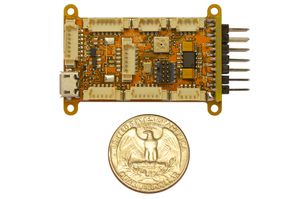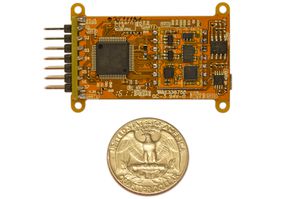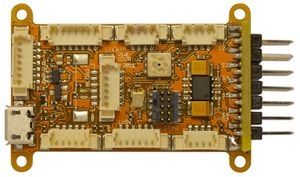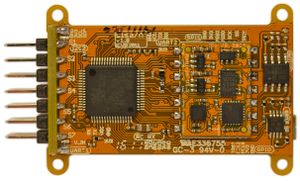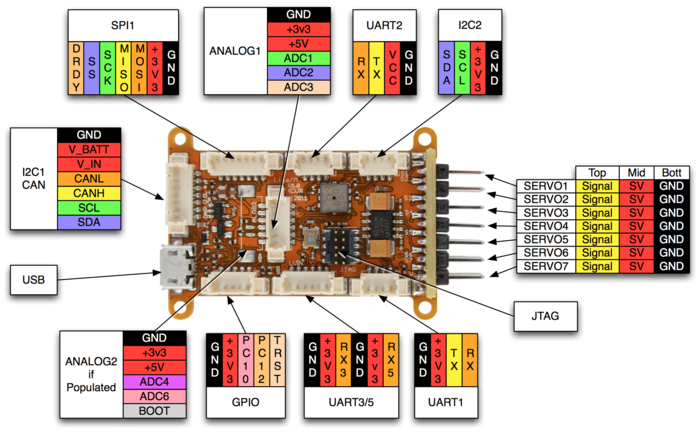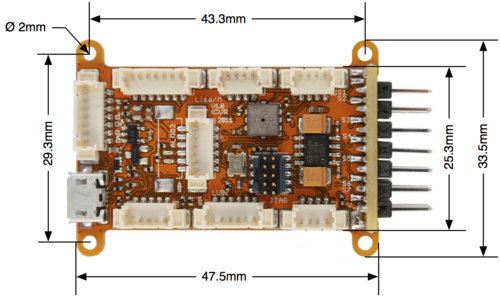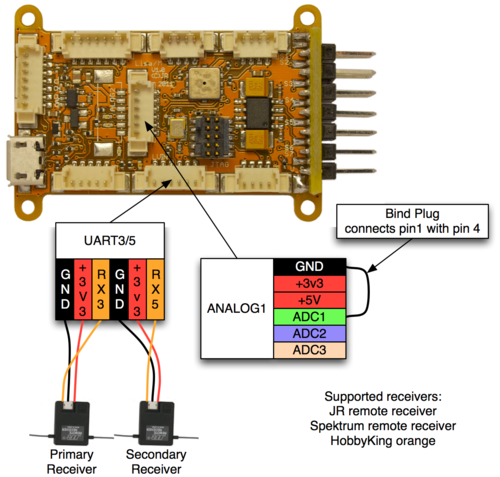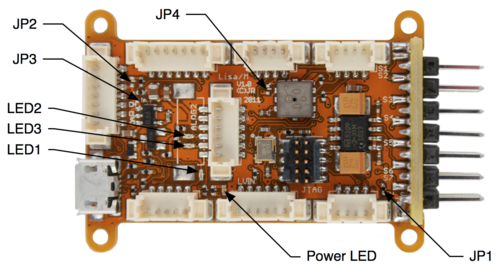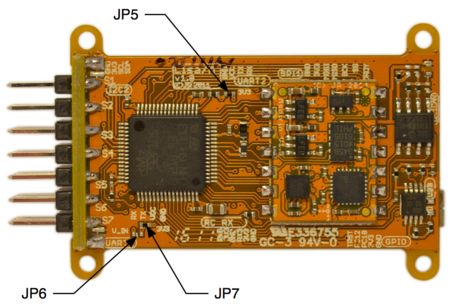Difference between revisions of "User/LisaM"
m |
m (→Introduction) |
||
| Line 1: | Line 1: | ||
= Introduction = | = Introduction = | ||
If you consider yourself a developer this | If you consider yourself a developer this flexible piece of UAS hardware is for you. If you enjoy writing software and consider yourself an early adopter this is the board to use. Have fun implementing and extending the already great features. To show of your work and also to ask questions, you are welcomed on the paparazzi mailinglist, this Wiki and the freenode paparazzi IRC channel. This nice piece of hardware can be used for various purposes. Ofcourse as an Autopilot board, but only by uploading another firmware also a servo extension board and more. A good idea of how this nice piece of hardware looks like is shown on the Photos here. | ||
[[Image:Lisa_M_V1_0_top_with_coin.jpg|thumb|Lisa/M V1.0 top view]] | [[Image:Lisa_M_V1_0_top_with_coin.jpg|thumb|Lisa/M V1.0 top view]] | ||
Revision as of 10:04, 8 June 2011
Introduction
If you consider yourself a developer this flexible piece of UAS hardware is for you. If you enjoy writing software and consider yourself an early adopter this is the board to use. Have fun implementing and extending the already great features. To show of your work and also to ask questions, you are welcomed on the paparazzi mailinglist, this Wiki and the freenode paparazzi IRC channel. This nice piece of hardware can be used for various purposes. Ofcourse as an Autopilot board, but only by uploading another firmware also a servo extension board and more. A good idea of how this nice piece of hardware looks like is shown on the Photos here.
Features
Lisa/M is based on the 64 pins STM32F103RE processor featuring 64k of RAM and 512k of FLASH. All the pins are exposed, providing access to the complete set of the STM32 peripherals.
Overview
- Single STM32 MCU
- 7 x Analog input channels
- 3 x Generic digital in-/out-puts
- 2 x 3.3V TTL UART (5V tolerant)
- 7 x Servo PPM outputs
- 1 x CAN bus
- 1 x SPI bus
- 1 x I2C bus
- 1 x Micro USB
- 4 x status LEDs with attached test point
- ? grams (? oz)
- ~30mm x ~50mm (" x ")
- 2 layers PCB design
with mounted IMU has the following additional sensors on board:
- 3 Axis Gyroscope
- 3 Axis Accelerometer
- 3 Axis Magnetometer
- Pressure sensor
The pressure sensor is mounted directly on the board as this sensor is not provided by Aspirin. Exept for a GPS unit you have all necessary sensors for full attitude and altitude stabilization in an extremely small package. Adding only an external GPS unit, it is a full fledged Autopilot.
Footprint
This autopilot is very small. The footprint is only 30mm by 50mm. It will fit in a small UAS very well. There is a spot for mounting the Aspirin IMU directly on board.
MCU
In brief, the STM32 features 3 USARTS, 2 SPI, 2 I2C, 1 CAN, a plethora of timers, ADCs and a generic DMA able to serve all of them. On the board, a number of the communication interfaces are level shifted with user selectable voltage to allow interfacing with all kind of peripherals.
Onboard IMU
The Lisa/M comes with Aspirin IMU mounted, for easy attitude estimation in the smallest package possible.
JTAG
Information about debugging can be found here
Hardware Revision History
v1.00
Architecture
Usage scenarios
As a basic Autopilot
As a servo extender
As a Safety Pilot Device
As a Data Logger
As a Camera controller
Pinout
Pins Name and Type are specified with respect to the Autopilot Board
Schematic
Electrical Connections to the Airborne Equipment
PCB
Gerber & Drill Files
Assembly
Components Layout
Mechanical drawing
Bill Of Material
Initial Setup
The section will contain some information about how to get the Lisa/M board up and running and where to connect other hardware for use as an AP board. If you are skilled and have a good knowledge of the hardware it would be great if you could create a separate wiki page for this. As we all know, this is a Wiki after all.
Bootloader
To awake the Hardware from sleep and activate the "Brain" a so called "Bootloader" is used.
Firmware
For the board to perform some sort of action, a "Brain" a.k.a Firmware must be uploaded to the board
Connect RC Receiver
To be able to test your UAS a RC receiver comes in very handy. One must realize without a receiver an well tuned airframe can fly very well, however for initial tests adding a receiver makes life so much easier... The de documenrtation here will describe how to connect and setup such an RC receiver.
PPM receiver
A modified RC receiver with full PPM out can be used to control the AP board from the ground. How to get a receiver with full PPM out or modify an existing one can be found here.
PPM is at the moment sharing a line with servo6, because it's the way it was wired on a Lisa/L board. It would be trivial to adapt the driver to use another line. look at sw/airborne/arch/stm32/subsystems/radio_control/ppm_arch.c . If you manage to do so please adjust the text on this page also.
Satellite Receiver
Connecting a 2.4GHz Spectrum or compatible receiver
It is very well possible to connect another 2.4Ghz receiver, however the software to interact with that device must at the moment be written by oneselfes. THe advantage of Opensource is that it is possible. Sharing your coding work would be great and in line with the GPL license.
Power supply jumpers
It is possible to reconfigure the electrical system on Lisa/M using the supply jumpers.
- JP1 connects the servo power rail to V_IN rail.
- JP2 connects the battery rail (used by default only for battery voltage measurement) to the V_IN rail.
- JP3 bypasses the +5V voltage regulator and connects V_IN to the +5V rail.
- JP4 connects the +5V rail to the VCC pin on the UART2 connector.
- JP5 connects the +3V3 rail to the VCC pin on the UART2 connector.
- JP6 connects the +5V rail to the VCC pin on the UART1 connector.
- JP7 connects the +3V3 rail to the VCC pin on the UART1 connector.
IMU callibration
PCB and assembled boards suppliers
For private companies and enthusiast Paparazzi hardware suppliers, see Get Hardware page.
Downloads
Source files
- download LisaM v1.00 Eagle design (zip)
Gerber & Drill files
- download gerber & drill files (zip)
Assembly files
- download (pdf)
- download (zipped .xls file)
